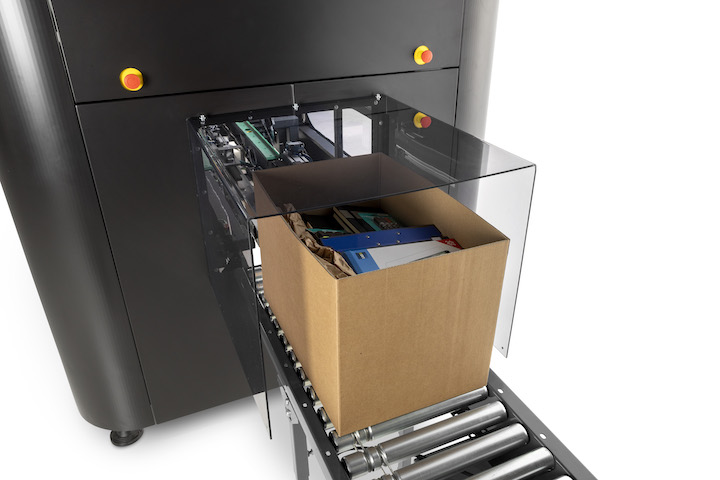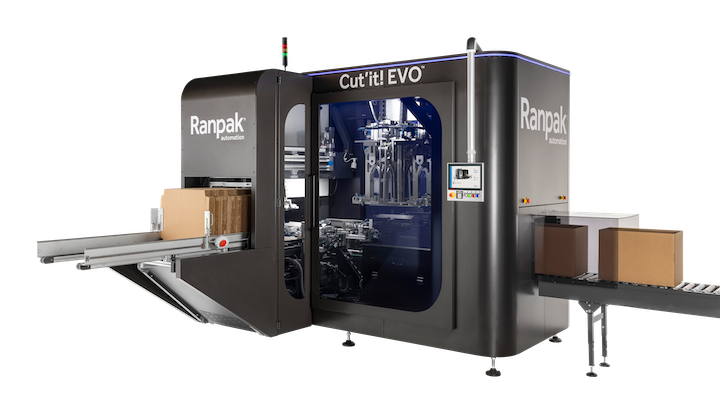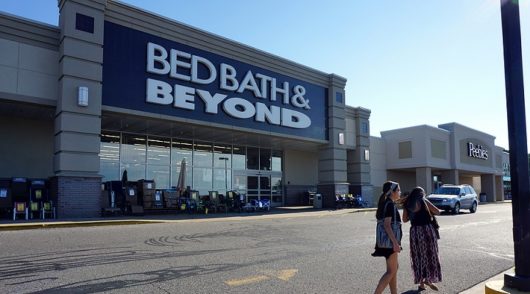As consumers expect more environmentally sustainable solutions for the packaging of products and deliveries, shippers may be missing equally compelling reasons to make the switch: significant cost savings and an increase in operational flexibility.
Saar Davidi, innovation director, automation, at Ranpak says a combination of new technologies and sustainable materials is making it easier for marketplaces and retailers to satisfy consumer expectations – and suggests that those not taking advantage of them are potentially leaving cost savings on the table.
For example, Ranpak’s automated Cut’it! EVO automated packaging solution senses the height of the tallest item packed in a carton, cuts the box flaps to this height, places a lid and seals a tamper-proof box with eco-friendly hotmelt glue.
Ranpak has embraced sustainable packaging materials since the company was formed 50 years ago and has always been paper-based. During the past five years, as consumer and regulatory pressure has forced manufacturers and retailers shipping goods to deliver sustainable solutions, Ranpak has continued to benefit, its technology deployed by major multinational brands and local e-commerce companies alike in 52 international markets.
Firstly, by being able to adapt the height of boxes, the company can reduce the number of box sizes warehouses need to stock – in one case a Ranpak client was able to replace 11 boxes with just five, reducing storage space and inventory requirements. The cube that comes off the packing line is as small as possible to wrap the goods inside.

With shipping rates placing increasing cost pressure on shippers, reducing the size (volume) of boxes and packages used can cut delivery fees, especially over the last mile.
Davidi, who is also a guest lecturer in logistics at RMIT University, says the global trend – especially in Australia – is for shippers to pay by cubage, not dead weight. Given shipping is usually an online retailer’s largest expense, it obviously makes sense to reduce package size.
Companies transitioning to adaptable boxes can achieve up to a 30 per cent reduction in volume. “If your boxes are 30 per cent smaller it will have a substantial direct effect on your shipping costs and cost of materials,” says Davidi. “So, there’s the first saving, right there.”
For some retailers, a ‘pick to shipper’ methodology can be used, which means picking the orders directly to the box shipped to the customer without the need for a plastic tote, which can potentially add another significant reduction in operating costs and increase the site’s throughput.
An environmentally-friendly paper protection product can also drive a substantial reduction in returns because there is less damage to goods inside the package and less shrinkage, thanks to the boxes being glued rather than taped shut, making it easier to detect tampering. This process can also be automated with Ranpak’s AccuFill system which senses the exact amount of void in the picked box through a vision system and automatically feeds the void with eco-friendly paper-based void fill and then automatically seals the random-sized boxes.
One shipper Davidi cannot name for confidentiality reasons reported a 50 per cent reduction in customer complaints.
Eco-friendly paper and glue
As demand for eco-friendly, sustainable packaging solutions grows, the sector is able to invest more into material innovation and is more commercially viable than before, reducing the prices of raw materials – essentially paper and glue – and bridging the gap between paper and traditional plastic solutions that negatively impact the environment.
While large retail organisations are coming under pressure from governments to reduce the amount of plastic they use in packaging, smaller players are under pressure from their customers.
“Retailers and suppliers have no choice really. They need to move towards sustainable packaging as their consumers increasingly demand that. But because of the economies of scale, it’s more affordable.”
Plastic packaging, he says, used to be substantially cheaper than eco-friendly alternatives like cardboard and paper, but this is less and less the case as the cost differences are approaching parity. And Davidi argues there is a price to pay – in terms of brand reputation – for not switching away from plastic.
“Leaving cost aside, how do you put a price tag on the perception about you as a customer and as a seller? How do you know a customer did not buy from you because you use plastic delivery packaging? There’s a high likelihood of customers moving to alternative brands that are environmentally friendly.
“People do care, so the pressure is everywhere.”
Many e-commerce and omnichannel companies shipping goods have traditionally used air-filled plastic pouches, polystyrene or other eco-unfriendly fillings to reduce movement inside boxes during transit. But this is no longer necessary. Davidi says Ranpak machine-fills voids with paper that can be virgin (and recyclable), post-industrial, recycled or post-consumer recycled.
The damage caused by mistaken identity
Another trend Davidi highlights is a shift away from using plastic-alternative packaging materials that might look like plastic but be fully biodegradable. Several of Ranpak’s clients that were using solutions like starch-based alternatives to polystyrene blocks to absorb shocks and cushion electronics or glassware have started dropping them. They found that consumers could not tell the difference between plastic or plant-based alternatives and there were cases of customers ignorantly claiming on social media that brands were not keeping their promise to phase out plastics.
“We have clients who are saying: whatever it is, if it looks like plastic, let’s ditch it. Even if we say on the product, it’s not plastic, if it looks like plastic or it feels like plastic, leave it. It’s paper or nothing.”
If you want to learn more about Ranpak’s environmentally friendly packaging solutions, take a look at the company’s website.






